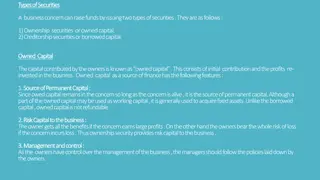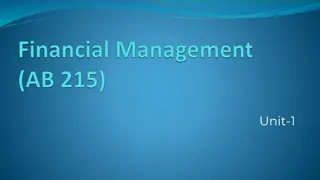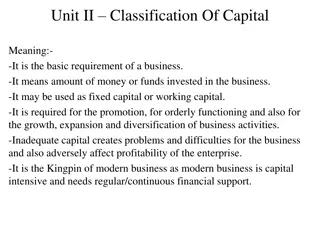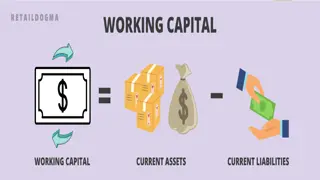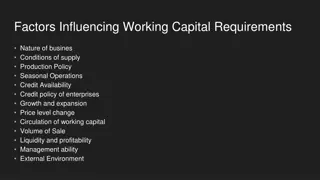Effective Working Capital Management in Business
Working capital management is crucial for businesses to optimize cash flow and ensure operational efficiency. It involves balancing current assets and liabilities, with a focus on accounts payable, accounts receivable, inventory, and cash. Proper management of working capital is essential for business success and sustainability, as it impacts liquidity and financial health. Various concepts, such as quantitative and qualitative approaches, define working capital to guide effective management practices.
Download Presentation

Please find below an Image/Link to download the presentation.
The content on the website is provided AS IS for your information and personal use only. It may not be sold, licensed, or shared on other websites without obtaining consent from the author.If you encounter any issues during the download, it is possible that the publisher has removed the file from their server.
You are allowed to download the files provided on this website for personal or commercial use, subject to the condition that they are used lawfully. All files are the property of their respective owners.
The content on the website is provided AS IS for your information and personal use only. It may not be sold, licensed, or shared on other websites without obtaining consent from the author.
E N D
Presentation Transcript
INTRODUCTION Working capital management is a business process that helps companies to make effective use of their current assets and optimize cash flow. Working capital is essential to the health of every business and improving your working capital position can provide a boost to the operational efficiency of a business, but managing it effectively is something of a balancing act . Companies need to have enough cash available to cover both planned and unexpected costs, while also making the best use of the funds available to fuel growth. This is achieved by the effective management of accounts payable, accounts receivable, inventory, and cash.
It has been often observed that the shortage of working capital leads to the failure of a business. The proper management of working capital may bring about the success of a business firm. The management of working capital includes the management of current assets and current liabilities. A number of companies for the past few years have been finding it difficult to solve the increasing problems of adopting seriously the management of working capital.
A firm may exist without making profits but cannot survive without liquidity. The function of working capital management in an organization is similar that of the heart in a human body. Also it is an important function of financial management. The financial manager must determine the satisfactory level of working capital funds and also the optimum mix of current assets and current liabilities. He must ensure that the appropriate sources of funds are used to finance working capital and should also see that short term obligation of the business are met well in time.
Concept of Working Capital Concept of Working Capital Management Management There are two concepts of working capital viz. quantitative and qualitative. Some people also define the two concepts as gross concept and net concept. According to quantitative concept, the amount of working capital refers to total of current assets . Current assets are considered to be gross working capital in this concept. The qualitative concept gives an idea regarding source of financing capital. According to qualitative concept the amount of working capital refers to excess of current assets over current liabilities.
L.J. Guthmann defined working capital as the portion of a firms current assets which are financed from long term funds. The excess of current assets over current liabilities is termed as Net working capital . In this concept Net working capital represents the amount of current assets which would remain if all current liabilities were paid.
Both the concepts of working capital have their own points of importance. If the objectives is to measure the size and extent to which current assets are being used, Gross concept is useful; whereas in evaluating the liquidity position of an undertaking Net concept becomes pertinent and preferable. It is necessary to understand the meaning of current assets and current liabilities for learning the meaning of working capital, which is explained below.
assets It is rightly observed that Current assets have a short Current Current assets life span. These type of assets are engaged in current operation of a business and normally used for short term operations of the firm during an accounting period i.e. within twelve months. The two important characteristics of such assets are, (i) short life span, and (ii) swift transformation into other form of assets. Cash balance may be held idle for a week or two; account receivable may have a life span of 30 to 60 days, and inventories may be held for 30 to 100 days.
Current Current liabilities liabilities The firm creates a Current Liability towards creditors (sellers) from whom it has purchased raw materials on credit. This liability is also known as accounts payable and shown in the balance sheet till the payment has been made to the creditors. The claims or obligations which are normally expected to mature for payment within an accounting cycle (1 year) are known as current liabilities. These can be defined as those liabilities where liquidation is reasonably expected to require the use of existing resources properly classifiable as current assets, or the creation of other current assets, or the creation of other current liabilities.








